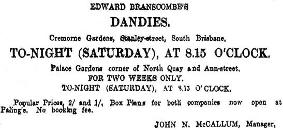The Dandies costume comedy troupes were conceived by Edward Branscombe following his experiments with the Scarlet Troubadours (previously the Scarlet Mysteries). The first troupe, which debuted at the Arcadia open-air theatre in the Melbourne seaside suburb of St Kilda on 9 November 1909, was billed as The Jesters. Made up of eight members, the ensemble would dress in a variety of period costumes. In a 1915 Theatre Magazine feature article, Branscombe describes that troupe as having been dressed in costumes of the time of Richard the Lionheart and Robin Hood. The men wore Lincoln green suits with red facings, hose, and tan belts and shoes, while their hats were adorned with red quills, with the exception of one performer who wore the cap of the professional jester. The three women were costumed in russet brown with muslin chemisettes, red underskirts, and 'natty little caps with white quill feathers.' The stage, set up as a forest glade, was framed in a proscenium of gold and chocolate (October 1915, p.28).
By 1911, Branscombe had established several troupes that toured initially under the generic title The Dandies, the name reflecting the elegant style of costuming. Each troupe, comprising around a dozen performers and a music director/pianist, was later distinguished by a colour: hence the Orange Dandies, Green Dandies, Pink Dandies, Red Dandies, Violet Dandies, and Scarlet Dandies. According to Branscombe, each troupe had its own almost exclusive repertoire, which meant that he was required to employ a person just to collect and co-ordinate the musical numbers to avoid unnecessary repetition. This person, along with several other senior practitioners and managers, would also collaborate with Branscombe (as composer) on many of the original songs presented in the Dandies' repertoire. The entrepreneur further notes that his concept for the organisation involved each troupe establishing its own distinctive features, so that each rotating season offered patrons something new. Thus, one troupe would specialise in part singing, another in musical scenas, and yet another in burlesque and comedy sketches. In addition to his managerial responsibilities with the Dandies, Branscombe arranged numerous musical pieces for publication, including instrumental numbers from well-known 'serious' composers and popular folk melodies that he turned into songs in collaboration with various lyricists.
The Dandies companies maintained a significant presence around Australia throughout the First World War period and, in this respect, played a particularly important role in the country's cultural development, particularly in the smaller, more far-flung capital cities of Brisbane, Hobart, and Perth. The Brisbane Courier records in its 14 March 1914 edition, for example, that the troupe then playing the theatre had been responsible for 'introducing the Tango to Brisbanites.' Led by Florence Henderson and Herbert Walton (in specially designed Spanish costumes), the troupe demonstrated both the ballroom and stage versions, with the latter being described as 'much more elaborate' (p.8).
The demand for continually changing entertainment meant that Dandies performers were drawn from various entertainment areas, both in Australia and from overseas (mostly from Commonwealth countries, however). The performers were fully experienced professionals (Branscombe did not provide amateur trials), who were required to read music and be multi-skilled entertainers. Some were originally from the concert and operatic stage, others from music hall and vaudeville, while a number of performers had specialised in musical comedy or had previously worked on the dramatic stage. Indeed, many of the Dandies performers had already established high-profile careers prior to joining Branscombe's operations, with their CVs including local theatrical organisations such as J. C. Williamson's and the Melba Opera Company. Others were engaged from overseas or after coming off contracts in Australia following tours with international companies. His Australia operations between 1911 and 1918 saw Branscombe effectively employ more than sixty performers at a time, in addition to advance reps and production staff (scenic artists, costume designers, and makers, etc). Among the most recognisable performers from this era were Claude Dampier, Howard Hall (later with Jim Gerald Revue Company), Walter George and Georgie Martin, Maud Fane, Arthur Mack, Mona Thomas (later with Jim Gerald, Ike Delavale, and Kate Howarde), Fred Monument, Miss Pop Batterbury, Percy Mackay, Harry Borradale, George Edwards, Joe Brennan, and Ida Newton.


